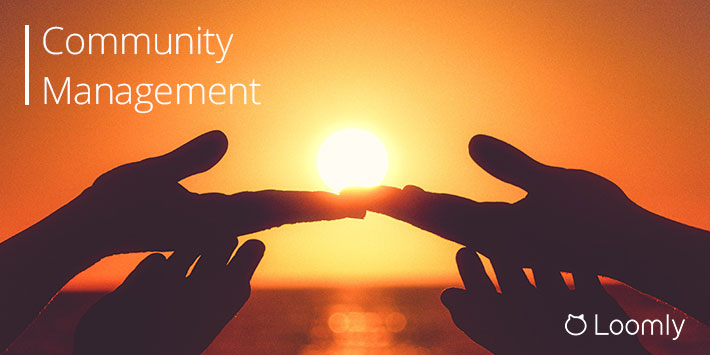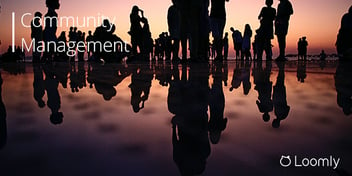Community Management: How to Build the Right Audience for Your Brand
Community management is often mentioned as an after-thought to social media marketing. But, in reality, it’s just as, if not more, important.
Successful brands know this, and use community management to build their online presence and increase brand advocacy through their fans and followers.
In this guide, you’ll learn how to build the right audience for your brand using the right type of community management.

Manage all your social media accounts in one place.
Craft, schedule, & auto-post content to all your social channels, then track analytics and manage interactions from a single, easy-to-use dashboard.
What is Community Management?
Community management is the practice of building an authentic community either externally among your customers or internally among your employees and partners, through various types of interactions.
Brands use both online and offline opportunities to create a network in which they can connect, share, and grow. A brand’s community may be spread across multiple platforms, such as social media, forums, blogs, YouTube, and Quora.
Types of Community Management
There are six types of community management as defined in the SPACE model:
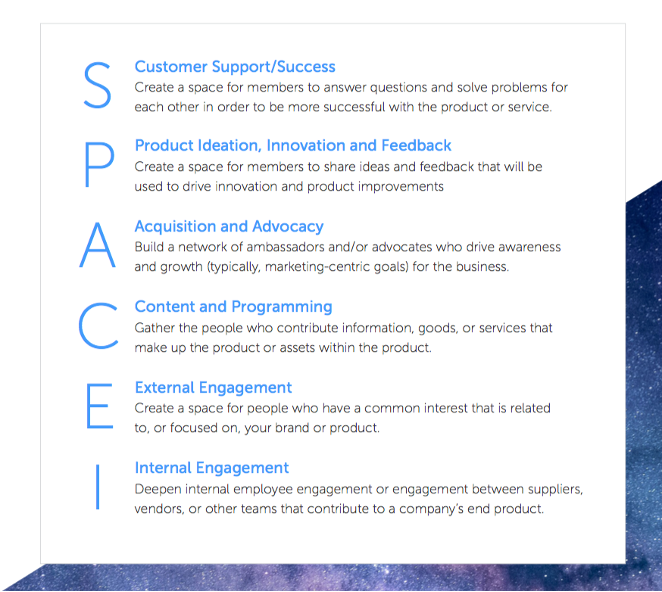
S: Customer Support and Success
Members answer questions and solve problems for each other to be more successful. You’re probably most familiar with this type of community. It might be a customer support forum, like Apple’s StackExchange, where people ask product questions, and the community answers them. Or it might be a customer success platform, like Udemy’s Instructor Community, where members help each other use a product more successfully.
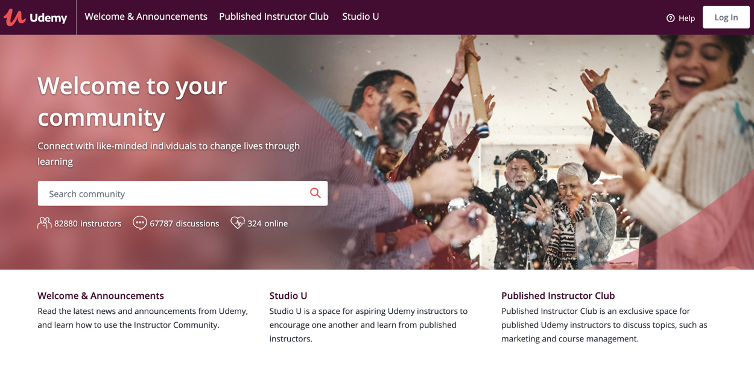
P: Product Ideation, Innovation, and Feedback
Members share ideas and feedback in a community that drives innovation and product improvements. This type of community management is ideal for companies like Atlassian and Vimeo, who ask for feedback from customers and members of their target audience on how they can improve their products.
A: Acquisition and Advocacy
Creating a network of customers, ambassadors, and brand advocates who drive awareness and growth. This type of community is closely connected to influencer marketing and allows members to help you build brand awareness and promote your products and services through various methods such as word-of-mouth, affiliate programs, and social media. For example, The Skimm has a brand ambassador program, called the “Skimm’bassador”, for users who get ten people to sign up for the media company’s content.
C: Content and Programming
Building a community of the people who contribute the content that makes up the product or other assets. For example, companies like GoFundMe, Airbnb, and Product Hunt have created platforms where people contribute content, such as their fundraisers and rental properties, to make them successful.
E: External Engagement
Building a community of people who have a common interest related to or focused on your brand or product. For example, Nike created its Running Club for people who love running:

Likewise, Sephora created its Beauty Insider Community for members to ask questions, join challenges, and get recommendations about beauty:
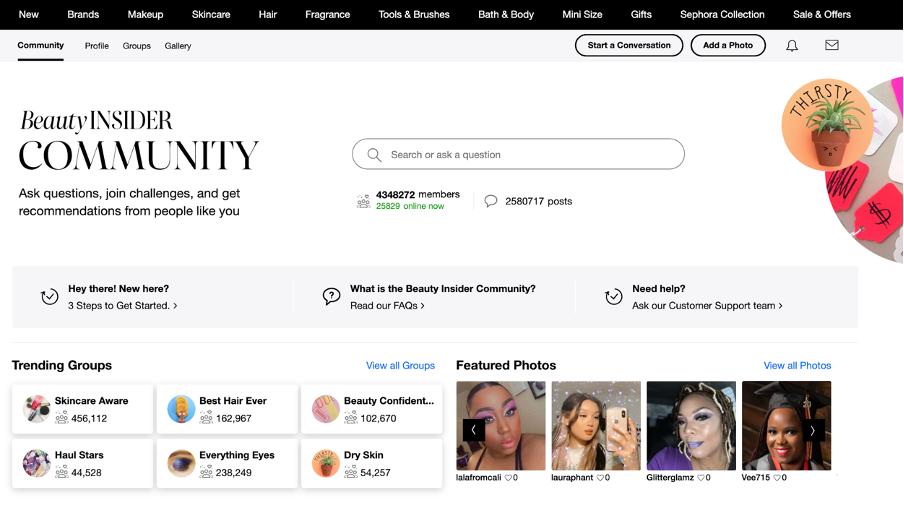
I: Internal Engagement
Building a community of employees or partners to extend engagement for those working with the brand. This is the least used type of community management. Tech, space, and financial companies like Microsoft, NASA, and Wells Fargo use internal communities to connect their global teams.
Community Management vs Social Media Management
Although community management is a key aspect of social media strategy, it is not the same.
Social media management refers to the creation, publishing, reviewing, and improvement of a brand’s social media content. Brands use social media to reach new customers and communicate with existing ones.
Community management takes place after your social media publishing. So it’s part brand monitoring, part customer service, and part being active in discussions that relate to your brand.
Community management typically starts on a smaller scale, but it has the power to build your brand’s presence differently from social media management.
Why Community Management Matters More Than Ever
Community management has grown in popularity and is used in all types and sizes of organizations, from small startups to large enterprises. It allows your brand to:
- Collect feedback and ideas from your customers and audience members through genuine conversations.
- Provide support for your customers, members, and fans when required.
- Increase brand and product awareness among your target audience.
- Discover what your customers want, expect, and need in terms of content, products, services, and support.
- Build one-on-one and one-to-many relationships between audience members and your brand.
- Increase customer interactions, engagement, and revenue.
- Provide added value to your customers besides your product or service.
Examples of Successful Community Management
Let’s take a look at three examples of successful community management.
Wendy’s
Wendy’s uses social listening to monitor for brand mentions and respond accordingly. A few years ago, they sparked the viral hashtag #NugsForCarter with a simple reply to a customer tweet.
Carter Wilkerson @carterjwm asked Wendy’s @Wendys how many retweets he’d need for a year’s supply of free nuggets. To which Wendy’s responded, “18 million”:
HELP ME PLEASE. A MAN NEEDS HIS NUGGS pic.twitter.com/4SrfHmEMo3
— Carter Wilkerson (@carterjwm) April 6, 2017
Carter didn’t quite reach 18 million, but it was the most retweeted tweet of all time, and he got lots of famous retweets along the way. Wendy’s gave him a gift card for a year’s worth of free nuggets and a $100,000 donation in Carter’s name to the Dave Thomas Foundation for Adoption (@DTFA).
Glossier
Beauty brand Glossier knows how to harness the power of its social community. By using content from the Glossier user community, its brand is instantly recognizable and relatable.
Even their social media tagline reinforces community:
Glossier Inc. is a people-powered beauty ecosystem
Skin first, makeup second
For instance, on Instagram, they feature user-generated content, like this clip of “Things to do while masking”:
They also take care of their community with initiatives like the Community Resource Pamphlet:
In this edition, they teamed up with other brands @morganharpernichols, @purpl.moon, and @theshineapp so that users could check in with their emotional and mental well-being.
Harley Owners Group
Harley-Davidson has one of the best community membership clubs where its customers exchange information and tips about their motorcycles. The Harley Owners Group, affectionately known as the HOG by its members, is a close-knit community of loyal customers who share their interests and experiences to build a better community spirit.
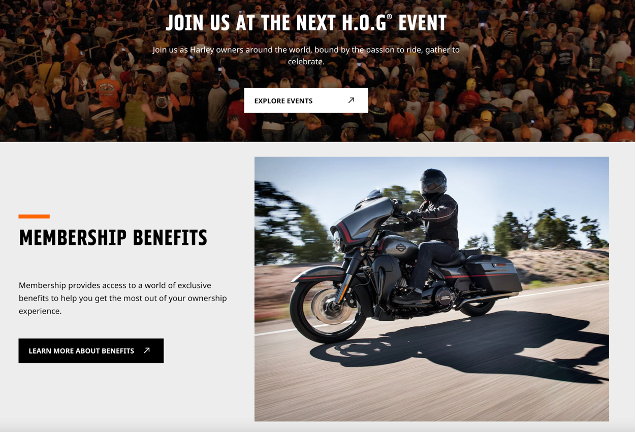
The HOG brings additional revenue to the company as members typically spend 30% more than other Harley owners on merchandise such as clothing and Harley-Davidson-sponsored events.
How to do Community Management Right
As you know from earlier, there are several types of community management. But in this section, we’ll focus on using external engagement through social media with these seven steps:
- Choose your community channel
- Listen to your audience
- Research your audience preferences
- Determine your success factors
- Set your goals and objectives
- Post consistently and engage diligently
- Measure your performance
1. Choose your community channel
The first step is to choose the social media channel(s) where you’ll manage your community. Consider your target audience demographics.
For example, if you’re targeting B2B professionals, then LinkedIn would be ideal. But if you’re targeting a younger B2C audience, then Instagram probably fits better. Of course, you can have more than one channel depending on your target audience and the resources and bandwidth you have available to manage multiple communities.
2. Listen to your audience
Taking the first step one stage further, you’ll need to identify what type of content your audience engages with on your chosen platform. For example, do they interact more with video content compared to images? Do they engage more with long posts rather than short ones?
At this stage, you should also be monitoring and listening to your audience to get a thorough understanding of what makes them tick. You can use a social listening tool or Google Alerts to track brand mentions, competitors, and specific keywords.
From your listening analysis, you can create a document detailing:
- Topics that create a negative or positive reaction
- Content from you (and your competitors) that gets more engagement
- Industry themes you want to track.
- Influencers in your industry or niche.
- Common hashtags in your industry.
3. Research your audience preferences
In step three, you’ll conduct further audience research and tests.
For example, you could:
- Test and track different kinds of posts to see which is receiving the best engagement and identify who is responding.
- Conduct polls to directly ask users what kind of content they want to see from your brand.
By reaching out at this early stage, you’re demonstrating to users that you want to build a dynamic community with conversations flowing in both directions.
4. Determine your success factors
With your background research complete, it’s time to decide the success factors for your brand’s community management efforts. Here are a few to consider:
- Gain more followers and community members.
- Boost your brand awareness.
- Raise customer satisfaction scores and retention levels.
- Increase sales and revenue.
- Improve overall engagement (likes, shares, mentions, hashtags, messages, comments).
5. Set your goals and objectives
Like all marketing strategies, you need to set goals and objectives to measure your success. Plus, you need to ensure you align them with your business and marketing goals.
For example:
- Business goal – increase customers
- Marketing goal – increase leads and conversions
- Community management goal – increase followers and community members
(You’ll refer back to these later.)
6. Post consistently and engage diligently
With your research and goal setting complete, you can focus on posting content and engaging with your audience. This step is at the heart of community management – interacting with your audience is where you build your brand advocacy.
Post consistently
Based on your audience and content research, you should be publishing the type of content that your audience wants to interact with. But you also need to ensure you post consistently to keep your fans and followers engaged.
Interact with your audience
Interacting with your audience is where you start to build relationships. You can use social listening tools here to listen for mentions of your brand and respond accordingly, as well as replying to and liking comments and messages on your posts.
You’ll recall from the earlier examples how brands like Wendy’s listen for brand mentions and jump into relevant conversations.
You can also encourage users to create content that you can promote on your channels as a way to build your community, like Glossier and GoPro on Instagram. Sharing user-generated content is a great way of demonstrating the authenticity of your social media channel and building your community.
Moderate comments
Part of community management also involves weeding out comments and conversations that don’t add any value, such as automated bot posts or deliberate trolling. However, you’ll also need to listen for genuine customer complaints and act positively to turn around a potentially harmful situation.
7. Measure your performance
Finally, it’s time to measure your performance based on the goals you set earlier.
Community management performance needs to allow for qualitative and quantitative results. For example, if you look at the increase in followers (quantitative) alongside the sentiment of comments (qualitative), you can determine if people have followed you because they like your brand or want to see how you respond to negative feedback.
You can track results via the social channel’s built-in analytics or use third-party tools for more in-depth analysis. Check which content is engaging your community members the most so that you can plan accordingly.
Community Management in a Nutshell
Let’s wrap up this guide with a quick recap:
Community management is the practice of building an authentic community either externally with customers or internally with employees and partners.
There are six types of community management:
- Customer Support and Success
- Product Ideation, Innovation, and Feedback
- Acquisition and Advocacy
- Content and Programming
- External Engagement
- Internal Engagement
Follow these seven steps to get your community management right:
- Choose your community channel
- Listen to your audience
- Research your audience preferences
- Determine your success factors
- Set your goals and objectives
- Post consistently and engage diligently
- Measure your performance
